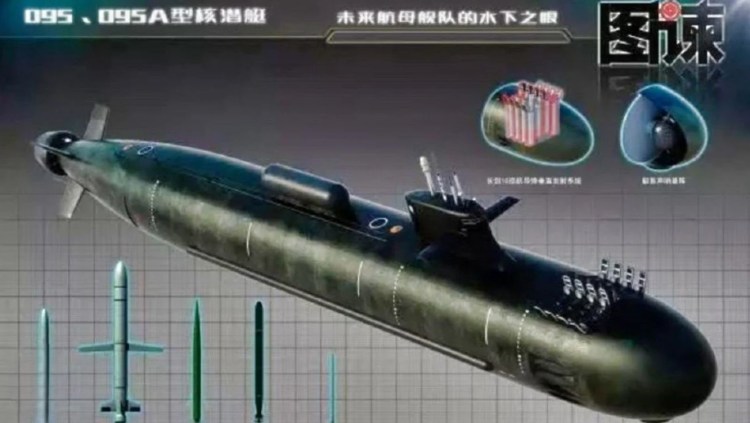The Chinese military is known for its secrecy, but a recent incident involving the sinking of one of its submarines has thrust them into the spotlight once again. Multiple reports and analyses suggest that the People’s Liberation Army Navy (PLAN) has lost a submarine under mysterious circumstances. However, as is often the case with Chinese military matters, the truth appears to be buried beneath a thick veil of denial and misdirection. Here’s what we know about the alleged cover-up of the submarine sinking and how the Chinese government has handled the fallout.
A Mysterious Incident
Reports about the submarine sinking began to circulate online in mid-2024, following unusual activity in the South China Sea, a critical and highly disputed maritime region. These reports, originating from international military monitoring groups and unconfirmed leaks, claimed that a Chinese submarine had failed to surface during routine operations. China maintains a fleet of six nuclear-capable submarines, and the Pentagon confirmed last year that they keep at least one out to sea at all times.
The vessel, identified by some sources as a Zhou-class nuclear-powered attack submarine, had supposedly gone off the grid for several days before any search and rescue efforts were noticed. What actually happened was, according to US intelligence sources, that it sank while tethered to a pier.
A senior US Defense official stated:
“It is not surprising that the PLA Navy would try to conceal the fact that their new first-in-class nuclear-powered attack sub sank pier side. In addition to the obvious questions about training standards and equipment quality, the incident raises deeper questions about the PLA’s internal accountability and oversight of China’s defense industry, which has long been plagued by corruption.”
The sub likely sank between May and June. Satellite images, such as the one below from Rated Red, show multiple cranes working to raise the ill-fated sub.
Image Credit: Rated Red. Check out their IG and YouTube channel.
The Chinese Government’s Silence and Disinformation
The initial response from the Chinese government was, predictably, silence. China has a long history of keeping military mishaps under wraps, and this event was no different. Chinese state-run media outlets made no mention of any submarine accident, and official channels continued with their regular broadcast of military triumphs and naval exercises.
The Chinese military is known for its secrecy, but a recent incident involving the sinking of one of its submarines has thrust them into the spotlight once again. Multiple reports and analyses suggest that the People’s Liberation Army Navy (PLAN) has lost a submarine under mysterious circumstances. However, as is often the case with Chinese military matters, the truth appears to be buried beneath a thick veil of denial and misdirection. Here’s what we know about the alleged cover-up of the submarine sinking and how the Chinese government has handled the fallout.
A Mysterious Incident
Reports about the submarine sinking began to circulate online in mid-2024, following unusual activity in the South China Sea, a critical and highly disputed maritime region. These reports, originating from international military monitoring groups and unconfirmed leaks, claimed that a Chinese submarine had failed to surface during routine operations. China maintains a fleet of six nuclear-capable submarines, and the Pentagon confirmed last year that they keep at least one out to sea at all times.
The vessel, identified by some sources as a Zhou-class nuclear-powered attack submarine, had supposedly gone off the grid for several days before any search and rescue efforts were noticed. What actually happened was, according to US intelligence sources, that it sank while tethered to a pier.
A senior US Defense official stated:
“It is not surprising that the PLA Navy would try to conceal the fact that their new first-in-class nuclear-powered attack sub sank pier side. In addition to the obvious questions about training standards and equipment quality, the incident raises deeper questions about the PLA’s internal accountability and oversight of China’s defense industry, which has long been plagued by corruption.”
The sub likely sank between May and June. Satellite images, such as the one below from Rated Red, show multiple cranes working to raise the ill-fated sub.
Image Credit: Rated Red. Check out their IG and YouTube channel.
The Chinese Government’s Silence and Disinformation
The initial response from the Chinese government was, predictably, silence. China has a long history of keeping military mishaps under wraps, and this event was no different. Chinese state-run media outlets made no mention of any submarine accident, and official channels continued with their regular broadcast of military triumphs and naval exercises.
When confronted with questions from the international media, the Chinese government refused to acknowledge any such incident. In typical fashion, they deflected inquiries and stuck to their well-worn playbook of emphasizing sovereignty and military prowess. State media did not mention a submarine accident, and official spokespeople described foreign reports as “baseless rumors” aimed at tarnishing China’s reputation.
China’s handling of military incidents, especially involving its navy, is deeply rooted in preserving the image of invincibility. This practice is nothing new—historical precedents, like the cover-up surrounding the 2003 submarine disaster that killed all 70 sailors on board, reveal a pattern of secrecy that ensures such tragedies remain hidden from the public eye. In that incident, a Chinese Ming-Class submarine, identified as submarine 361, sank following a catastrophic training accident that occurred in the Yellow Sea off China’s northeast coast.
In this latest case, the Chinese government actively suppressed information, and state-run outlets appeared to push an alternate narrative. Shortly after rumors about the submarine’s sinking began to circulate, Chinese media shifted focus to the “successful” completion of a major naval exercise in the South China Sea, showcasing submarines and other naval assets. This redirection of attention is a classic disinformation strategy meant to detract from any negative press.
Potential International Consequences
The international community, particularly China’s neighboring Southeast Asian countries, is watching this situation closely. As such a sensitive maritime region, any military incident, particularly involving nuclear assets, could have serious ramifications.
Serious questions have been raised regarding its environmental and military impact. A nuclear-powered vessel going down in these waters presents a potential environmental disaster. It is not clear if there was radioactive material onboard the sub at the time it sank or not. Additionally, losing a Zhou-class submarine would represent a major blow to China’s growing naval ambitions, weakening its position in the strategic power struggle with the U.S. and other regional players. The sinking comes just as the US, UK, and Australia have agreed to build and sell more nuclear-powered attack submarines. Australia is to purchase the war machines to help fortify its Navy. These subs are exactly what is needed to patrol the area and track Chinese missile subs in their own backyard.
Conclusion: A Pattern of Secrecy
The Chinese government’s handling of the submarine sinking follows a clear pattern of military secrecy and suppression of information. A Chinese Foreign Ministry official recently stated, “We are not familiar with the situation you mentioned and currently have no information to provide.”
Whether or not the entire truth about this incident will ever come to light remains uncertain, but the signs of a cover-up are strong. If the past is any indicator, this event will likely join a long list of unacknowledged military mishaps concealed to preserve the narrative of a formidable, faultless Chinese military.
As the international community continues to dig for answers, one thing is clear: China’s regional strategic interests will always take precedence over transparency, even when lives are at stake.
—
Disclaimer: SOFREP utilizes AI for image generation and article research. Occasionally, it’s like handing a chimpanzee the keys to your liquor cabinet. It’s not always perfect and if a mistake is made, we own up to it full stop. In a world where information comes at us in tidal waves, it is an important tool that helps us sift through the brass for live rounds.



